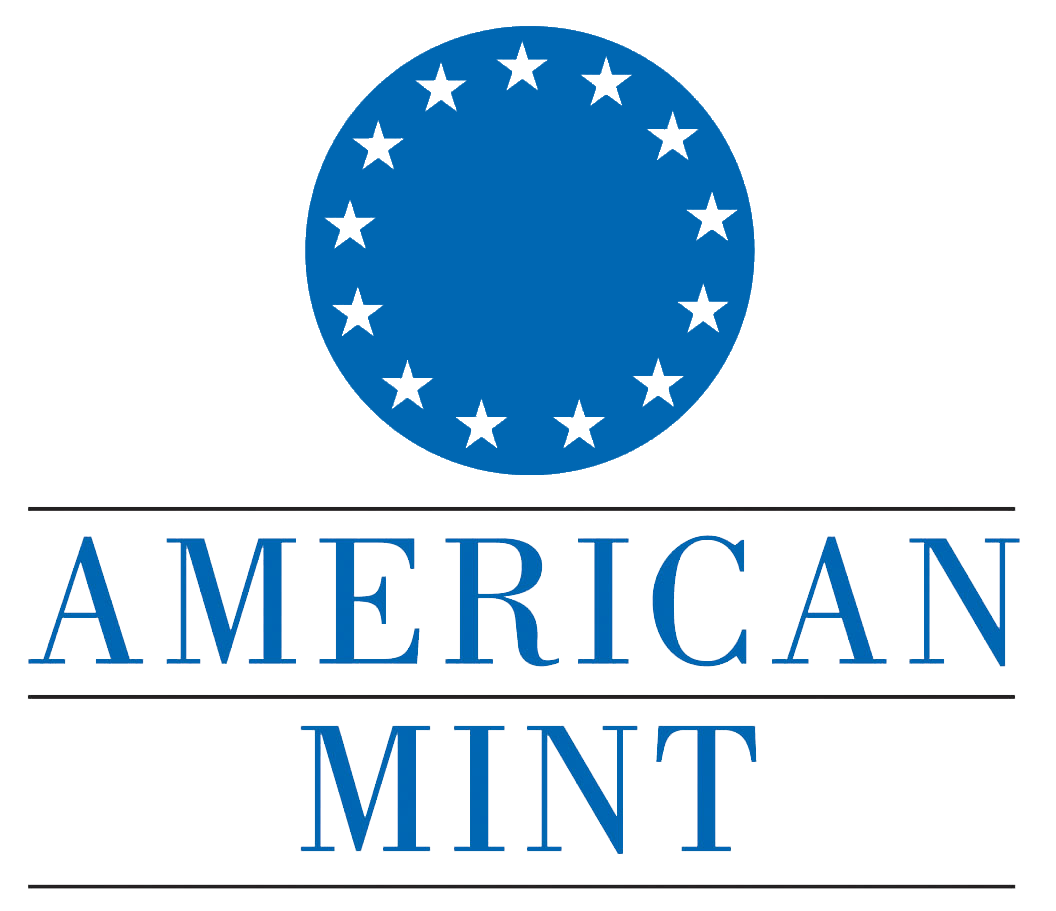
Coin collecting is a time-honored pursuit that people have enjoyed for decades and even centuries. Countless people, generation after generation, agree that there’s something special about hunting down a rare or valuable coin and finally finding it, after sometimes years of searching. There’s satisfaction to be had in learning all there is to know about certain sets of coins, and it’s enjoyable to attend coin shows and browse online auctions for those coins you’re looking to add to your collection.
However, there’s no denying that coin collecting isn’t always the easiest hobby to jump into. For someone who's just getting started, the amount of coin collecting terms and jargon being thrown around can be overwhelming. The novice coin collector might wonder what coin grading is, or what a business strike means, or what in the world a die is. This is where our coin glossary comes in.
We believe that if you want to begin collecting coins, then you should be able to do so without feeling the barrier of incomprehensible jargon. To help you out and introduce you to some of the most common coin collecting terminology you’re likely to run into, we’ve put together this guide of numismatic terms. Here, we hope you’ll find definitions for all the coin terminology you’ve been wondering about.
Your Guide to Basic Coin Collector Terminology
These coin terms are listed alphabetically for your convenience.
- Alloy: This is a combination of two or more metals that have been mixed together to form a new metallic compound. For example, a coin may be made from a nickel and tin alloy.
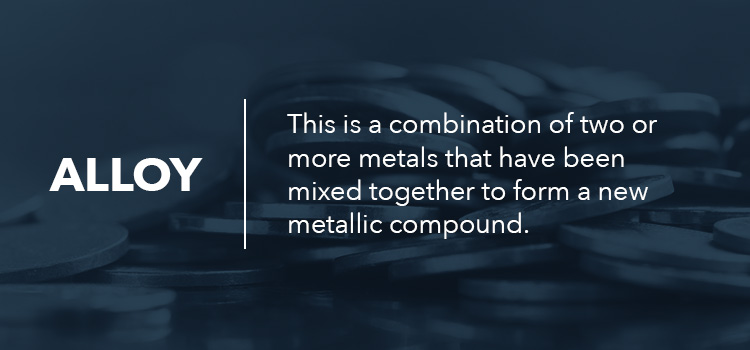
- Almost Good: Also known as "about good," this is the third-lowest category in the coin-grading scale.
- Almost Uncirculated: A highly desirable category ranking on the coin-grading scale, this is the highest category with the exception of Mint State and uncirculated coins.
- Altered: A coin might be altered in an effort to fool and defraud collectors. This might include changing mint marks, using artificial toning, changing the dates or more to make a coin appear more or less valuable than it really is. These types of alterations are easy to spot by a professional with a magnifying glass.
- Annealing: This is the process of heating the blank metal planchets when making a coin, to soften them before minting.
- Artificial Toning: An attempt to change the appearance of a coin, usually to make it appear more valuable than it is. This typically involves the use of chemicals to sharpen a coin’s color, and it often creates a dark brown color that may appear spotty. A professional will easily be able to spot this type of treatment.
- Assay: A test designed to evaluate the purity and weight of a coin.
- Attribution: Any distinguishing features on a coin that are used for identification. This might include the date, denomination, or mint mark, among other things.
- Bag Mark: Newly minted coins are typically placed in cloth bags as they’re delivered out to banks and other locations. This can cause the coins to jumble around inside the bags, bumping against one another and causing scratches or other dings known as bag marks.
- Base Metal: This is a metal or alloy made only of non-precious metals, meaning it contains no silver or gold.
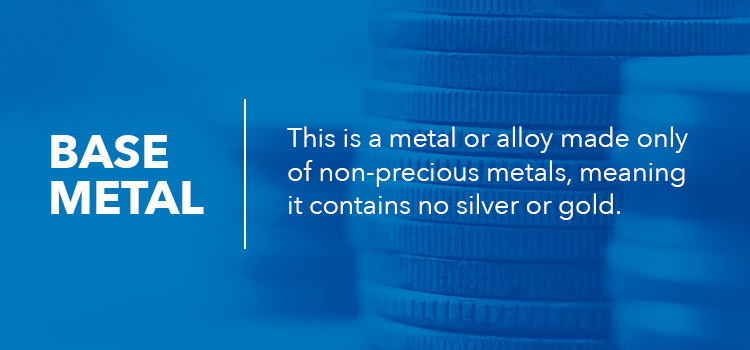
- Basining: The process of polishing a die face.
- Beading: Beading is the border of raised dots that you’ll often find around the edge of a coin.
- Billon: A low-grade alloy formed by combining a small amount of gold or silver with a large amount of a less valuable metal, such as copper.
- Blank: This is a prepared disc of metal onto which the coin design will then be stamped. These are cut from large sheets of prepared metal alloy, at which point they are known as Type I blanks. They then must be milled to achieve a small rim along the edge, at which point they become Type II blanks.
- Brass: An alloy of copper and zinc.
- Brockage: This is a coin that has been struck with a die that already had a coin in it, meaning that a brockage coin will have an inverted image of the first coin imprinted into it.
- Bronze: An alloy of copper and tin.
- Bullion: Bullion refers to precious metal such as platinum, silver or gold in the form of ingots, bars or any other format where quantity is counted as the valuation.
- Business Strike: This is a coin that was struck with the intention of daily use in commerce and circulation. For example, the coins in your wallet or coin bank are all business-strike coins.
- Carat: This term is not to be confused with karat. Carat is a term for measuring precious stones, while karat is a term for measuring gold.
- Certified Coin: A coin that has been authenticated and graded by a reliable third-party grading service such as the Professional Coin Grading Service (PCGS) or the Numismatic Guaranty Corporation (NGC).
- Circulated: This term refers to a coin that has been circulated and thus has wear.
- Clad Coinage: Coins that have an inner core of one particular metal, covered in an outer layer of a different metal.
- Collar: The part of the die chamber that holds the blank in place as it’s being stamped.
- Commemorative: A term describing a limited edition coin that is released to honor a special person or event.
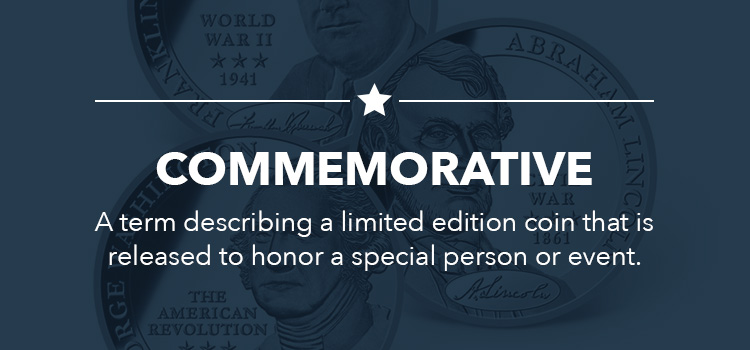
- Contact Marks: Abrasions or marks on uncirculated coins caused by the coins rubbing up against one another.
- Counterfeit: Any coin or imitation coin produced by an unauthorized mint.
- Debase: This refers to lowering the value of a silver or gold coin by lowering its purity levels, but without altering the market value. In other words, this creates a coin that isn’t truly worth its market value.
- Denticles: These are the tooth-like raised marks along the inside edge of a coin.
- Design: The design is the particular image or motif displayed on the coin, such as a person’s face, a Lady Liberty, or a landmark.
- Design Type: A term describing a certain motif that’s repeated across multiple coin types.
- Device: This is a special term to describe the particular images included in a coin’s design. For example, if a coin features an image of Lady Liberty, we would refer to her as the coin’s device.
- Die: A metal piece imprinted with the intended design for a coin that is used to stamp this image into blanks.
- Die Crack: A thin, raised line that may appear on a coin because of a crack in the die.
- Die Variation: This refers to minor changes that may appear in a die over the lifetime of a coin, resulting in slight appearance differences between two coins that are nominally the same design.
- Double Eagle: A well-known United States $20 gold coin.
- Double Strike: An error in coin production, caused when the die strikes a blank only to bounce and strike it again, creating a double imprint, with the second strike slightly offset from the first.
- Doubloon: Common term for a Spanish gold coin, originally worth $4.
- Eagle: A well-known United States $10 gold coin.
- Edge: Another term for the rim of a coin. An edge might be plain, or it might be decorated with any one of a variety of decoration such as reeds or lettering.
- Effigy: The image of a person on a coin.
- Engraver: The person who works to cut the image for the coin design onto the die.

- Error: A coin that acquired some type of mistake during production and that accidentally passed through inspection without being caught.
- Extremely Fine: A desirable category ranking on the coin-grading scale, this falls above both “fine” and “very fine.”
- Eye Appeal: A non-scientific term that simply describes a coin’s immediate appeal to the naked eye. For example, someone might say that a coin has great eye appeal, but this is not an official statement about its value, grade, or worth.
- Fair: The second-lowest category for a coin grade.
- Field: This is the background of a coin, where no design or inscription appears.
- Filler: Collectors might call a coin a filler if it is very worn, but it will do as a place-holder in their collection until they find one that’s in better condition.
- Fine: A category rating on the coin-grading scale, this is midway ranking that falls above both “good” and “very good.”
- Fineness: A term to describe how pure the gold or silver content in a coin is.
- Flan: A synonym for blank, or planchet, this is a blank metal disc that has yet to be stamped with the design.
- Gem: A coin that remains in exceptionally good condition. We might say that such a coin is gem-quality.
- Good: A mid-scale category rating on the coin-grading scale.
- Grade: This is the condition of a coin, based on the amount of wear it has received. To be seen as an official evaluation, this grade must be given by an official coin grading service, typically either the PCGS or NGC. A coin grade consists of both a category and a corresponding point score.
- Gripped Edge: An edge marked with a series of small grip marks or indentations around the circumference.
- Hairlines: Tiny lines on coins that may be caused by cleaning or polishing.
- Half Eagle: A well-known United States gold $5 coin.
- Hub: This is a metal object with a relief of the coin design on one end, exactly as it should appear on the final coin. A hub is critical to the process of producing dies, which in turn are used to create coins.
- Incuse: This is a term for any part of a coin’s design that is impressed into the surface. The opposite term is “relief,” which refers to any part of the design that is raised above the surface.
- Ingot: A pure metal in bar form. This term is usually only used to describe precious metals. For example, you might have a silver ingot, but you likely would never have a tin ingot.
- Inscription: Any lettering or numbers that appear on a coin.
- Intrinsic Value: The value of a coin, based solely on the precious metals contained inside. Think of this as the value of a coin if you were to melt it down and sell the precious metals by themselves.
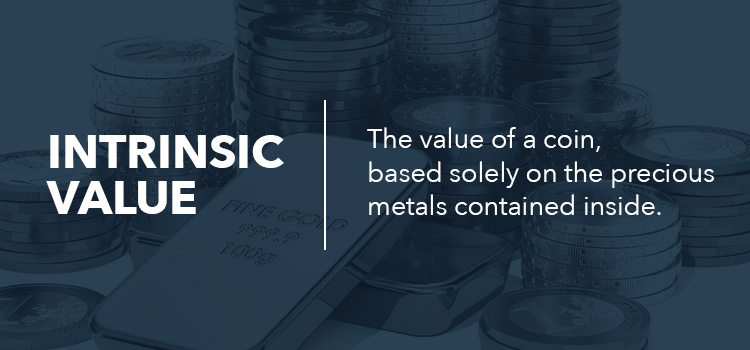
- Karat: This term is not to be confused with carat. Carat is a term for measuring precious stones, while karat is a term for measuring gold.
- Key Coin: The rarest or most valuable coin within a particular series.
- Key Date: A slang term often used to describe the rarest mint mark and date in a specific coin series.
- Laureate: In coins, a figure’s head may often be crowned with a laurel wreath. This is referred to as a laureate.
- Legal Tender: Coins that can actually be accepted as payment in ordinary places of business. For example, while ancient Roman coins may be highly valuable as collector’s items, they would not be considered legal tender.
- Legend: The primary inscription or motto on a coin.
- Lettered Edge: A term for when the outside edge of a coin is inscribed.
- Low Relief: A raised design that is not raised very high off the coin surface.
- Luster: The glossy brilliance of a coin is called luster. Based on how shiny a coin is, we might say it has high or low luster.
- Master Die: The main die from which all other, working dies are cast. This master die is the first one created from the original hub and is the primary reference for creating the coin.
- Milled Edge: A coin rim that is raised around the outer edge.
- Mint Error: A defective coin that was produced at a mint.
- Mint Luster: Different from ordinary luster, mint luster is a type of “frost” that can sometimes cover the surface of uncirculated coins.
- Mint Mark: Small design, symbol or letter on a coin that indicates which mint created it.
- Mint Set: This is a set of uncirculated coins, packaged and sold as a unit by a mint.
- Mis-Strike: A coin that has an off-center design due to an error in the striking process.
- Motto: A quotation or phrase on a coin. For example, American coins are stamped with the motto, “In God We Trust.”
- Mule: A term for a coin that was accidentally struck with two mismatched dies, creating a coin with a front and back not intended to go together. This is a rare occurrence, making these coins highly uncommon.
- Non-Circulating Legal Tender: Abbreviated as NCLT, these are coins that are technically legal tender, but that aren’t intended for circulation. Examples of this might be certain commemorative coins or extremely old coins.
- Numismatics: Numismatics is the field of coin studies.
- Numismatist: Someone who studies coins, or someone who collects coins and related objects.
- Obverse: The front side of a coin. Also referred to as the face side or “heads.”
- Off-Center: A coin that was off-center in the press when it was struck, meaning that the design is not directly centered on the coin.
- Over-Graded: This is a coin that is in worse condition than its grade appears to indicate.
- Overstrike: This is an impression in a coin created by a new die overtop of a previously struck coin.
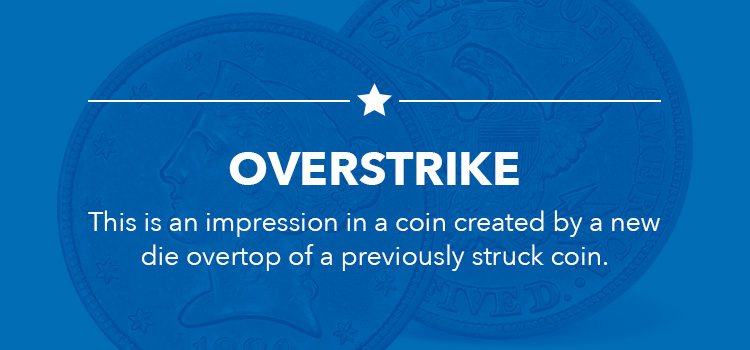
- Oxidation: This is when oxides collect on the surface of a coin and tarnish it. This is usually due to exposure to fumes, dampness or other contaminating elements.
- Patina: A kind of film that can collect on the surface of coins. It is caused by oxidation and is common for older silver, bronze or copper coins.
- Pedigree: A term referring to the previous owners of a particular coin.
- Planchet: Another term for a blank. This is a cut circle of prepared metal on which the die will stamp a design.
- Poor: The lowest possible category for a coin grade, this might also be referred to as basal.
- Press: The press is the actual machine used to produce the finished coin. It holds the prepared blank and the die in place and presses them together to create the coin.
- Privy: Also known as a privy mark, this is a small mark on a coin that indicates the mint master.
- Proof: Proof coins are those struck specifically for collectors, and are not intended to enter circulation. They are typically created using specially polished dies and planchets.
- Proof Set: A packaged set of proof coins, sold as a unit to collectors.
- Prototype: The original coin bearing the design intended for all other coins of this type. A prototype coin will typically bear the date of the year before the rest of the coins bearing the same design.
- Quarter-Eagle: A well-known United States gold $2.50 coin.
- Raw: This is a term for a coin that has not undergone any grading process.
- Reeded Edge: Coins with reeded edges will have grooved lines all around the perimeter. This is a synonym for the term “milled edge.”
- Relief: This is a term for any part of a coin’s design that is raised above the surface. The opposite term is “incuse,” which refers to any part of the design that is impressed into the surface.
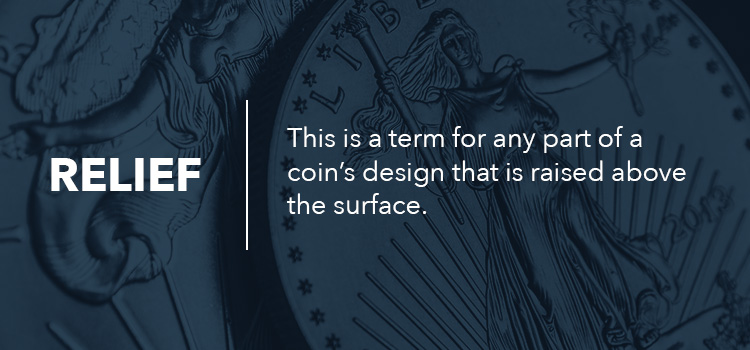
- Re-strike: A re-strike is a coin that originates from an authentic die, but comes from a later date than the original date of issue.
- Reverse: The back side of a coin. Sometimes known as the “tails,” this is the opposite side of the coin as the obverse.
- Rim: The raised edge of a coin that protects the flat surface of the coin from wear when placed flat on a surface.
- Round: A piece of precious metal that is shaped like a coin, but is actually just another form of bullion.
- Scratch: Similar to a nick, ding, or divot, this is simply another term for the types of abrasions that might mar the surface of a coin.
- Seignorage: The difference between the cost of producing a single coin at a mint and the face value of that same coin. In other words, seignorage is the actual profit that mint makes on a single coin.
- Series: If coins are minted several years in a row with a specific design and denomination, they are part of a series.
- Spot Price: The quoted market value for a specific precious metal in bullion form. This is highly subject to change depending on the time, date, and location, as this price simply refers to the price at that precise “spot” and moment.
- Striations: These are tiny, raised lines along the surface of a coin, commonly caused by too much polishing.
- Striking: The process of minting a coin, when the die strikes the blank and imprints it with the design.
- Strip: This is the large role of prepared metal from which blanks or planchets will be cut.
- Toned Coin: A coin that has been naturally toned, and thus has a slightly different color than a newly minted coin.
- Toning: Toning refers to the naturally occurring discoloration that takes place on the surface of a coin over time, due to natural air exposure.
- Trial Strike: This is a coin that is struck during the process of adjusting the die for the correct pressure. This usually results in a very weak strike.
- Uncirculated: A coin that has never entered circulation and that still retains all its original luster. This might also be known as a Mint State coin.
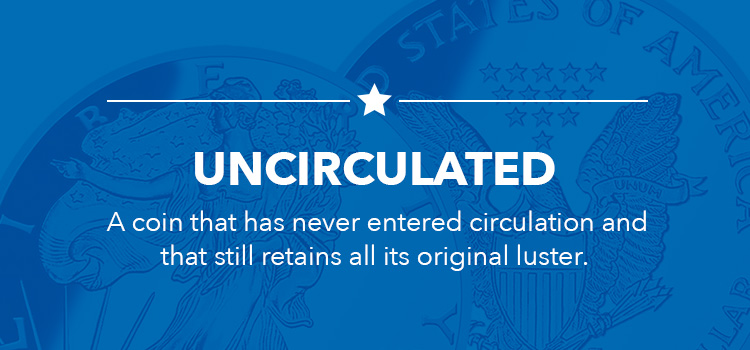
- Uniface: A coin with a design on only one side.
- Unique: If a coin is said to be unique, this means it is the only one of its kind in the world, as far as anyone knows.
- Variety: We might say there is variety in the design of a certain type of coin if the die changed slightly between different strikes.
- Very Fine: A category rating on the coin-grating scale that falls one step above “fine.”
- Very Good: A mid-scale category rating on the coin-grading scale, this is one step above “good.”
- Whizzing: A process whereby someone might try to make a coin appear more valuable by polishing it.
- Working Die: A die created from the reference of the master die, these working dies are the ones that actually are used to produce coins.
- Year Set: A year set of coins would have one coin from each relevant year, all of the same denomination and type.
Browse Our Coins Today

Feeling a little more ready to jump into some coin shopping now that you have these basic terms under your belt? Get started by browsing the coins available on our website. Every item from American Mint comes with a Certificate of Authenticity which certifies the size and materials. All our collections are curated exclusively by our experts, and many items are limited editions available only from American Mint. Start your coin collection today.
